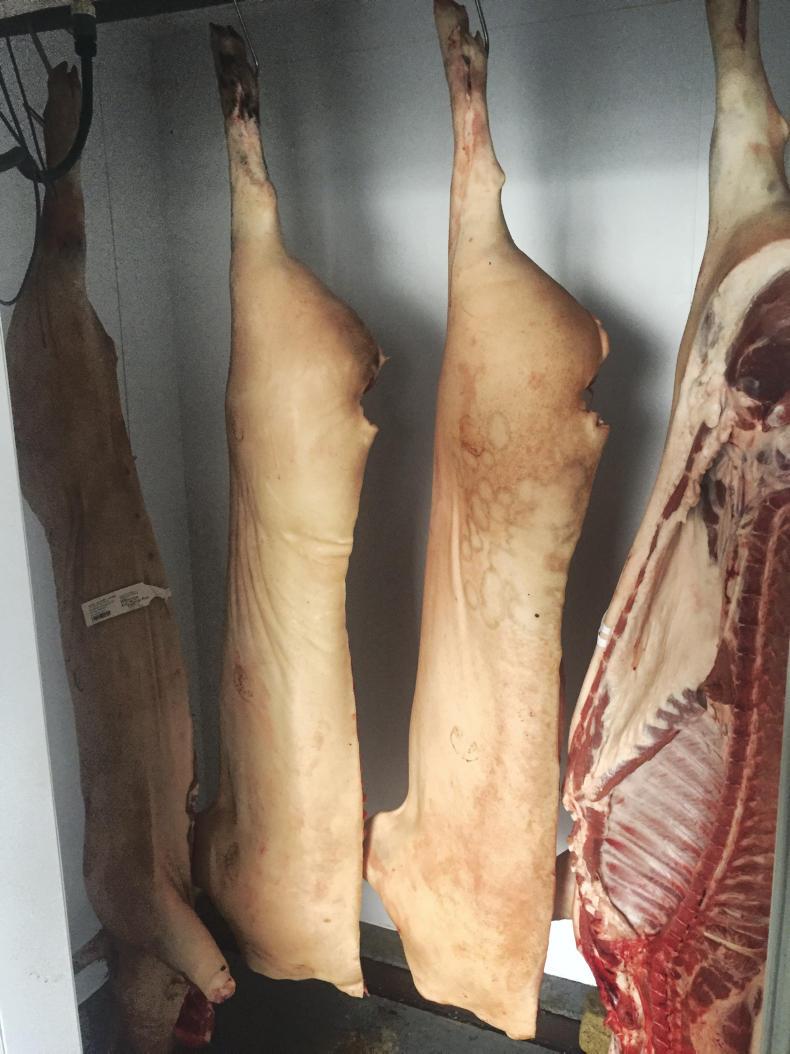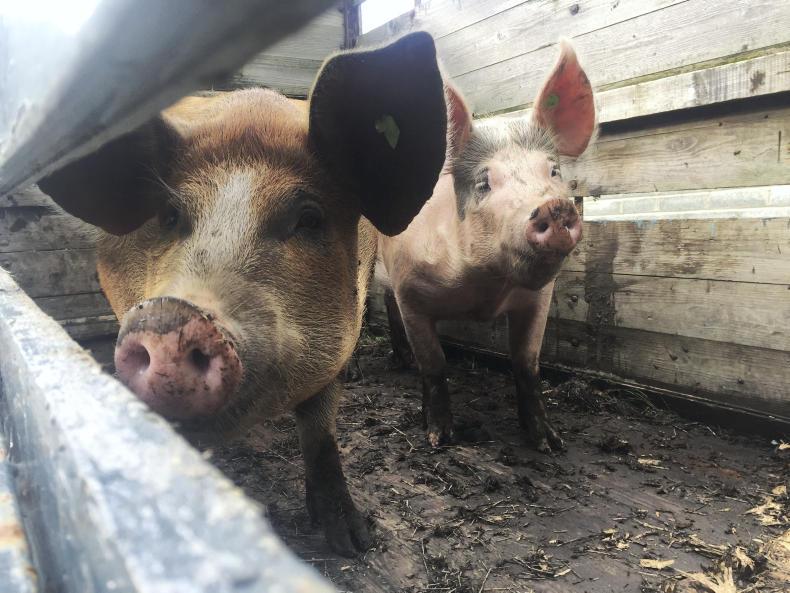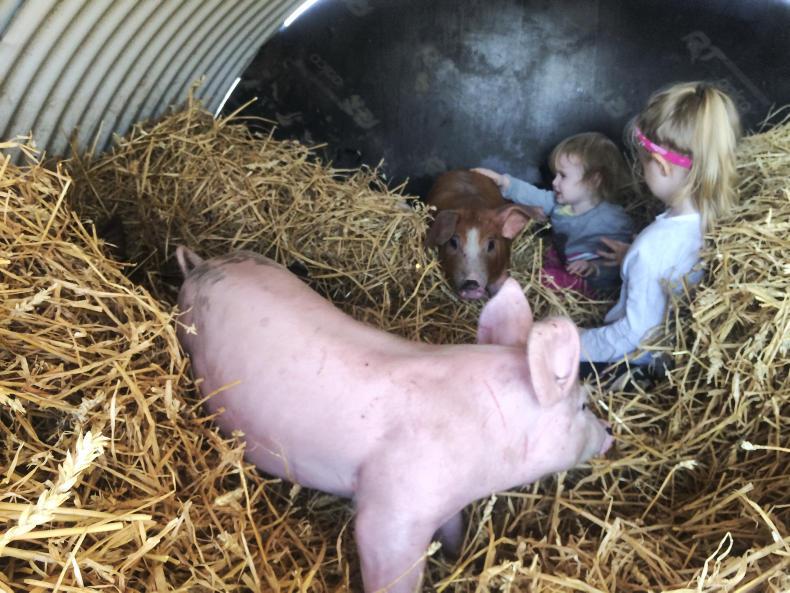In the world of small holdings, you hear a lot about pig-rearing; stories of great escapes and decimated gardens combined with the simple enjoyment of raising pigs, with their big personalities (and delicious end results).
John Griffin is a small holder from Co Carlow. He has experience in piggeries and a background in butchery. He also has a real passion for nature, so a small holding was a natural progression for him and his family.
“I got into pigs from my grandfather,” he says. “He used to rear pigs and cure his own bacon. Five years ago I set about getting my own pigs. We bought five acres and now have sheep, pigs, cows and chickens.”
Irish Country Living spoke at length with John about his experiences with pig rearing.
You need to apply for a pig herd number from the Department of Agriculture. You can learn more and apply online at www.agriculture.gov.ie. The National Pig Identification and Tracing System requires all pig owners to register and comply with welfare rules. Once you get your pigs, they must be tagged and their living area will be inspected.
Pigs need outdoor and indoor living areas. Their indoor area should be clean, with good ventilation and enough space for them to turn around, and sturdy enough to contain their destructive nature. While pigs can be kept in many different types of shelters, there are a few “personality traits” to consider before fencing them in.

Pig carcases are returned from the abattoir in two halves, which then need to be butchered.
“They’re going to dig; that’s a guarantee,” says John. “The outdoor area shouldn’t be too wet. You should put the pigs in an area that you want to reclaim or improve. They’re great for managing bracken and scrub.”
“I assign half an acre for my [five] pigs, and then the following year I plough that in for my vegetable garden,” he continues. “I rotate my garden every year to follow the pigs. The garden then reverts to grassland. But a much smaller living area (down to an eighth of an acre per five pigs) would also work.”
You need a serious fence for them
John also recommends taking a strong approach to keeping the pigs enclosed in their area.
“You need a serious fence for them,” he says. “A powerful electric unit is best. Last year, one of our pigs learned to jump the fence. Electric sheep netting is very effective.”
A good understanding of biosecurity is important before getting pigs. Serious disease outbreaks can occur if protocol set out by the DAFM is not followed. This includes guidelines on feed, transport, shelter and pest control.
Fencing is equally important, as pigs can escape and contract diseases in unmonitored areas. The DAFM has a detailed biosecurity pamphlet entitled Keepers of Non-Intensive and Pet Pigs available on their website.
When John first started keeping pigs, he chose heritage breeds – Berkshire, Tamworth and Kunekune. Once reared and butchered, he was pleased with the quality of their meat, but the following year and each year since he has kept commercial Large White crosses.
“It is difficult to get the fat ratio right on heritage breeds,” he says. “I like pigs with plenty of fat but it can be too much for some people.”
Heritage breeds are available and purchases can be arranged through the Irish Pig Society webpage (irishpigsociety.com). John has been happy with the Large Whites (sired by Pietrain and Duroc breeds). They are readily available, inexpensive and mature quickly.
“It’s not as easy to find the rare breeds, at times; you’d be waiting to get them,” he says. “After the first year, I got a few pigs from the commercial piggery up the road. Large Whites usually cost between €35 and €50 each. I get them as weaners; about 10 weeks old.”
Raising a commercial pig breed can be more cost effective and Large Whites can be a good breed to start with.
“It’s different when you raise it yourself,” John says. “Sure it’s the same pig you get in the supermarket, but it’s reared outdoors on a varied diet. The meat is totally different in texture and taste.”

Some of John's pigs on his five-acre holding in Co Carlow.
It is illegal to feed pigs anything “of animal origin” or that could have come in contact with such foods. According to the DAFM, “grass, cereals, commercially available feeds and fodder crops can be fed, as well as fruits and vegetables, as long as they do not contain or have not been in contact with other food waste.” Animal products can transmit highly contagious diseases like African swine fever. Offenders face a fine of up to €250,000 or three years in prison, or both.
We try to minimise chemicals and medicines, but you have to work within reason
“We do feed waste food, but it’s the right kind,” John says. “The waste our pigs get is vegetables and fruit that have gone off and garden waste, along with a constant supply of rolled barley.
“We try to minimise chemicals and medicines, but you have to work within reason. Barley is economical; we use it as a filler. They also forage a lot; digging up roots along with grass and plants.”
As they grow, pigs require greater amounts of food. Before butchering, John gives his pigs beef finisher from his local feed store, which is similar to pig finisher but costs significantly less.
Most pigs are bought as weaners - usually two to three months after being born, regardless of breed. If raising commercial Large Whites, it takes up to seven months to get to butchering weight. Heritage breeds will take longer (10-12 months) to get to butchering weight. “I have mine killed in October. 100kg is my ideal carcass weight for commercials,” John says. “That would be from a live weight of approximately 130-140kg. I would kill the heritage breeds much lighter, at about 70kg-100kg (liveweight), because of their high fat ratio.”

John allows his children to interact with the piglets, but as the pigs get bigger the girls are not allowed in with them. Pigs can easily knock children over and injure them.
When it’s time to butcher, there are a few things to consider. Animal welfare is always a concern and this includes transport to the abattoir. You can find a full guide to pig welfare on the Department of Agriculture website.
The tags you attach to your pigs will serve as traceability for your end product. Many choose to have their pigs killed at a licensed abattoir and processed by a butcher who can cure bacon and make sausages. Others, like John, butcher the carcase themselves after having the pigs killed. Abattoirs that will kill smaller numbers of pigs charge around €25-€50 per animal.
“There are not that many places left that will butcher pigs for you,” John says. “You need a butcher you can trust. You put so much work into raising your animals. Getting the cuts you want in the right portion sizes, along with proper packaging and labelling is a must.”
You can find butchers within your locality at craftbutchers.ie and enquire about whether they can process pigs. John, with friend Declan Gilmore, offers butchery courses at Regan Organic Farm in Co Wexford. You can find out more about these courses on their website (www.reganorganicfarm.ie).
In the world of small holdings, you hear a lot about pig-rearing; stories of great escapes and decimated gardens combined with the simple enjoyment of raising pigs, with their big personalities (and delicious end results).
John Griffin is a small holder from Co Carlow. He has experience in piggeries and a background in butchery. He also has a real passion for nature, so a small holding was a natural progression for him and his family.
“I got into pigs from my grandfather,” he says. “He used to rear pigs and cure his own bacon. Five years ago I set about getting my own pigs. We bought five acres and now have sheep, pigs, cows and chickens.”
Irish Country Living spoke at length with John about his experiences with pig rearing.
You need to apply for a pig herd number from the Department of Agriculture. You can learn more and apply online at www.agriculture.gov.ie. The National Pig Identification and Tracing System requires all pig owners to register and comply with welfare rules. Once you get your pigs, they must be tagged and their living area will be inspected.
Pigs need outdoor and indoor living areas. Their indoor area should be clean, with good ventilation and enough space for them to turn around, and sturdy enough to contain their destructive nature. While pigs can be kept in many different types of shelters, there are a few “personality traits” to consider before fencing them in.

Pig carcases are returned from the abattoir in two halves, which then need to be butchered.
“They’re going to dig; that’s a guarantee,” says John. “The outdoor area shouldn’t be too wet. You should put the pigs in an area that you want to reclaim or improve. They’re great for managing bracken and scrub.”
“I assign half an acre for my [five] pigs, and then the following year I plough that in for my vegetable garden,” he continues. “I rotate my garden every year to follow the pigs. The garden then reverts to grassland. But a much smaller living area (down to an eighth of an acre per five pigs) would also work.”
You need a serious fence for them
John also recommends taking a strong approach to keeping the pigs enclosed in their area.
“You need a serious fence for them,” he says. “A powerful electric unit is best. Last year, one of our pigs learned to jump the fence. Electric sheep netting is very effective.”
A good understanding of biosecurity is important before getting pigs. Serious disease outbreaks can occur if protocol set out by the DAFM is not followed. This includes guidelines on feed, transport, shelter and pest control.
Fencing is equally important, as pigs can escape and contract diseases in unmonitored areas. The DAFM has a detailed biosecurity pamphlet entitled Keepers of Non-Intensive and Pet Pigs available on their website.
When John first started keeping pigs, he chose heritage breeds – Berkshire, Tamworth and Kunekune. Once reared and butchered, he was pleased with the quality of their meat, but the following year and each year since he has kept commercial Large White crosses.
“It is difficult to get the fat ratio right on heritage breeds,” he says. “I like pigs with plenty of fat but it can be too much for some people.”
Heritage breeds are available and purchases can be arranged through the Irish Pig Society webpage (irishpigsociety.com). John has been happy with the Large Whites (sired by Pietrain and Duroc breeds). They are readily available, inexpensive and mature quickly.
“It’s not as easy to find the rare breeds, at times; you’d be waiting to get them,” he says. “After the first year, I got a few pigs from the commercial piggery up the road. Large Whites usually cost between €35 and €50 each. I get them as weaners; about 10 weeks old.”
Raising a commercial pig breed can be more cost effective and Large Whites can be a good breed to start with.
“It’s different when you raise it yourself,” John says. “Sure it’s the same pig you get in the supermarket, but it’s reared outdoors on a varied diet. The meat is totally different in texture and taste.”

Some of John's pigs on his five-acre holding in Co Carlow.
It is illegal to feed pigs anything “of animal origin” or that could have come in contact with such foods. According to the DAFM, “grass, cereals, commercially available feeds and fodder crops can be fed, as well as fruits and vegetables, as long as they do not contain or have not been in contact with other food waste.” Animal products can transmit highly contagious diseases like African swine fever. Offenders face a fine of up to €250,000 or three years in prison, or both.
We try to minimise chemicals and medicines, but you have to work within reason
“We do feed waste food, but it’s the right kind,” John says. “The waste our pigs get is vegetables and fruit that have gone off and garden waste, along with a constant supply of rolled barley.
“We try to minimise chemicals and medicines, but you have to work within reason. Barley is economical; we use it as a filler. They also forage a lot; digging up roots along with grass and plants.”
As they grow, pigs require greater amounts of food. Before butchering, John gives his pigs beef finisher from his local feed store, which is similar to pig finisher but costs significantly less.
Most pigs are bought as weaners - usually two to three months after being born, regardless of breed. If raising commercial Large Whites, it takes up to seven months to get to butchering weight. Heritage breeds will take longer (10-12 months) to get to butchering weight. “I have mine killed in October. 100kg is my ideal carcass weight for commercials,” John says. “That would be from a live weight of approximately 130-140kg. I would kill the heritage breeds much lighter, at about 70kg-100kg (liveweight), because of their high fat ratio.”

John allows his children to interact with the piglets, but as the pigs get bigger the girls are not allowed in with them. Pigs can easily knock children over and injure them.
When it’s time to butcher, there are a few things to consider. Animal welfare is always a concern and this includes transport to the abattoir. You can find a full guide to pig welfare on the Department of Agriculture website.
The tags you attach to your pigs will serve as traceability for your end product. Many choose to have their pigs killed at a licensed abattoir and processed by a butcher who can cure bacon and make sausages. Others, like John, butcher the carcase themselves after having the pigs killed. Abattoirs that will kill smaller numbers of pigs charge around €25-€50 per animal.
“There are not that many places left that will butcher pigs for you,” John says. “You need a butcher you can trust. You put so much work into raising your animals. Getting the cuts you want in the right portion sizes, along with proper packaging and labelling is a must.”
You can find butchers within your locality at craftbutchers.ie and enquire about whether they can process pigs. John, with friend Declan Gilmore, offers butchery courses at Regan Organic Farm in Co Wexford. You can find out more about these courses on their website (www.reganorganicfarm.ie).









 This is a subscriber-only article
This is a subscriber-only article






SHARING OPTIONS: